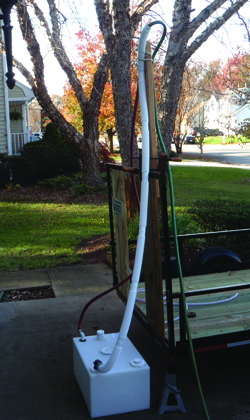Because of the critical nature of our test reports, it is important to clear up any errors as soon as possible. This blog article is part of that process. In the February 2012 issue, which will be available online next week and will soon arrive at subscribers mailing addresses, we tested two holding tanks-one from Trionic and one from SeaLand. Both tanks slightly leaked water while under pressure. The leaks were very small and occurredat top-mounted fittings that were supplied separately with the tanks and were installed by our tester according to the manufacturers instructions.

After the storys publication, SeaLand informed us that the tank we tested and recommended was not their most current model, which went into production in late 2009. According to SeaLand, the company has redesigned the cleanout cap/inspection port to make it easier to achieve a perfect seal at the cap. This was an area that leaked during our test.
Practical Sailor will be following up with a test report on the current SeaLand tank. In the meantime, it is important for readers to recognize that the tank we tested does not represent the companys latest line of products. In our update article, we will offer more detailed advice on how to test for leaks prior to installation and what products and measures can be used to seal the tank fittings.
Here is a statement from SeaLands Patrick Snyder clarifying the matter:
While HTS-Basic tank bodies are tested to meet ISO 8099 standards, the 90-degree inlet and discharge elbows, plug, and 3-inch clean-out cap are not installed and tested on every HTS-Basic tank. They are ‘ship loose’ items so the customer has the option to use the supplied fittings or ones of their choosing. Our customers insisted that they be shipped in this manner. As a result, the integrity of the completely plumbed tank depends on how the fittings are plumbed by the installer. On other SeaLand tanks that are shipped as completely assembled units (according to OEM specs), we have found plastic pipe sealant to provide a more consistent seal than the plumber’s tape that your installer reported using on our 90-degree elbows.
“Since the tank that PS tested is more than two years old, the clean-out cap does not have the new square-cut seal which provides a more stationary sealing surface when the cap is tightened. That change was made at the end of 2009. The square-cut seal would make it easier to achieve an airtight seal during installation, as the flat thick surface of the new seal maintains optimum positioning more consistently than the previous O-ring. However, when either the new seal or the previous O-ring are installed correctly, they provide the same airtight, watertight seal.
“Our pressure test for all holding tanks exceed both the CFR 159.109 and ISO 8099 standards. Currently we are testing to a maximum of 3.20 PSI – equivalent to approximately 7.38 feet of head. Importantly, we test with pressurized air to measurements of hundredths of PSI. Because air has more fluid and less self-sealing properties than water, we feel this test is more stringent than what CFR 159.109 stipulates. All tanks are required to pass this test before being shipped.
“We takethe issue very seriously and are investigating ways tohelp preventthe potential for even a single leak regardless of who installs the fittings.
































